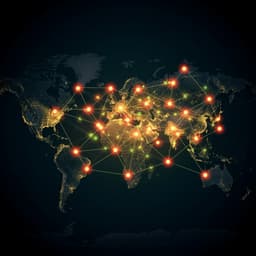
Biology
The global loss of floristic uniqueness
Q. Yang, P. Weigelt, et al.
This study reveals the alarming global trend of regional floristic uniqueness being compromised by the naturalization of alien plant species. Conducted by a diverse team of researchers, the findings underscore the urgent need for biodiversity conservation strategies as taxonomic and phylogenetic homogenization threaten the integrity of regional floras worldwide.
~3 min • Beginner • English
Introduction
The study investigates how human-mediated introductions and subsequent naturalization of alien plants have altered regional floras by eroding their taxonomic and phylogenetic uniqueness. Naturalized species can modify biotic interactions, cause hybridization, and shift or blur biogeographic boundaries, potentially affecting ecological integrity and even regional economic attractiveness (e.g., tourism). While biotic homogenization across large spatial scales has been reported for several taxa and networks, a global analysis for vascular plants was lacking. The authors posit that naturalized alien plants predominantly drive changes in regional floristic similarity (more so than native extirpations), and that both taxonomic and phylogenetic dimensions of uniqueness are affected. They hypothesize that homogenization between regions is influenced by biogeographic factors (geographic and climatic distance) and anthropogenic connectivity (trade, travel, and administrative ties), with expectations that naturalizations weaken the natural distance-decay in similarity, that climate matching promotes establishment and thus homogenization, and that current or historical administrative relationships facilitate species exchange, increasing similarity.
Literature Review
Prior work has established human introductions as a major force reshaping biogeography and increasing biotic homogenization across taxa (e.g., zoogeographical regions and freshwater fishes). The natural distance-decay of similarity is a pervasive biogeographic pattern, reflecting dispersal limitation and environmental dissimilarity. For plants, existing studies have been regional or continental rather than global. Conceptual and empirical literature highlights that naturalized species alter community composition and evolutionary dynamics, that climate matching strongly influences establishment success, and that globalization and colonial histories have mediated propagule pressure and spread. The authors build on these insights to test for global patterns in both taxonomic and phylogenetic homogenization of floras.
Methodology
Data sources and coverage: The analysis compiled native and naturalized vascular plant floras for 658 non-overlapping regions worldwide (countries and subnational units), covering 110 countries and 18,762 flowering plant species. Data were primarily synthesized from the GloNAF (Global Naturalized Alien Flora) database and GIFT (Global Inventory of Floras and Traits), after harmonizing regional boundaries and applying stringent quality criteria (e.g., >50% completeness of species lists). Some regions (notably in tropical Africa and Southeast Asia) lacked sufficient data.
Similarity metrics: For every region pair, the authors computed taxonomic (SimTax) and phylogenetic (SimPhyl) similarities for native floras, and for natives plus naturalized floras, using Simpson-type indices (including a phylogenetic analogue based on shared branch lengths). Phylogenetic similarity used a dated phylogeny to quantify shared evolutionary history. The degree of homogenization H for a pair was calculated as the log-response ratio of similarity with naturalized species included versus natives only, separately for taxonomic and phylogenetic dimensions.
Geographic and climatic distances: Geographic distance between regions was measured as the great-circle distance between region centroids (highly correlated with border-to-border distances). Climatic distance was quantified in a multivariate climate space using 19 WorldClim bioclimatic variables (2.5′ resolution). Variables were transformed toward normality and standardized; a PCA was performed and the first three orthogonal components were used to summarize climate. Overall climatic distance and component-wise distances (PC1 ~ temperature, PC2 ~ precipitation) were analyzed.
Administrative relationships: Current and historical administrative links between regions were compiled using global administrative datasets (e.g., GADM) and curated sources, including colonial relationships and dependent territories, to capture governance ties that may reflect trade and travel connectivity.
Statistical analyses: The authors examined how SimTax and SimPhyl (natives vs natives+naturalized) vary with geographic and climatic distance using nonlinear curve fitting. They assessed changes in the distance-decay (e.g., halving distances). To model determinants of homogenization (H), they used multiple regression on distance matrices (MRM) with predictors including geographic distance, climatic distance (or PC1/PC2), administrative relationships, and interactions, with permutation tests (999 permutations) to account for matrix non-independence. Generalized additive models (GAMs) were run as sensitivity analyses to assess potential nonlinearities, yielding qualitatively consistent results.
Regional hotspots and correlates: For each region, pairwise H values were averaged to quantify mean taxonomic and phylogenetic homogenization. Linear models related these means to regional characteristics: region area, native species richness, phylogenetic diversity, proportion of endemic species, richness of naturalized species, donor score (average number of non-native regions per native species), and insularity (island vs mainland). Predictors were transformed and standardized as appropriate, and spatial autocorrelation in residuals was addressed using spatial modeling with latitude/longitude covariates.
Key Findings
- Global homogenization: Naturalized alien plants caused widespread increases in floristic similarity between regions in both taxonomic and phylogenetic dimensions. In more than 90% of regions, taxonomic similarity increased; in about 77% of regions, phylogenetic similarity increased.
- Attenuation of distance-decay: Adding naturalized species made the geographic distance-decay of similarity less steep. The halving distance for taxonomic similarity increased from 1,791 km (natives only) to 2,638 km (natives+naturalized). For phylogenetic similarity, the halving distance increased from 7,008 km to 7,489 km.
- Geographic and climatic effects: Homogenization was strongest for geographically distant region pairs with similar climates; homogenization declined with increasing climatic distance, driven mainly by temperature differences (PC1), with weaker or contrasting effects of precipitation (PC2) on taxonomic homogenization.
- Administrative links: Region pairs within the same country, or with current/past administrative ties (e.g., colonial relationships, dependent territories), exhibited stronger increases in taxonomic homogenization with geographic distance than pairs without such links (ANCOVA comparisons P < 0.001). Patterns for phylogenetic homogenization were weaker or mixed.
- Disproportionate role of widely naturalized species: Removing the 10% most widely naturalized species significantly reduced both taxonomic and phylogenetic similarities, indicating these species disproportionately drive global homogenization.
- Hotspots and geography: Australasia and many oceanic islands are hotspots of taxonomic homogenization. Islands often showed comparatively lower phylogenetic homogenization (even coldspots) despite high taxonomic homogenization.
- Regional correlates (mean H): Mean taxonomic homogenization decreased with larger region size, higher native species richness, and stronger donor role, and increased with higher proportion of endemics and greater richness of naturalized species. Mean phylogenetic homogenization similarly decreased with region size and native richness; associations with donor role and endemism were weaker or non-significant, and native phylogenetic diversity was positively associated with mean phylogenetic homogenization.
Discussion
The findings support the concept of a progressing “New Pangea,” where human-facilitated plant movements erode long-standing biogeographic boundaries. By weakening the natural distance-decay in floristic similarity, naturalized species disproportionately homogenize distant regions that historically shared few species. Climate matching emerged as a key mechanism: regions similar in temperature regimes experience greater mutual naturalizations and thus stronger homogenization. Administrative ties reflect trade, transport, and policy linkages that enhance propagule exchange, leaving detectable signatures of contemporary and historical governance (e.g., colonial networks) in global homogenization patterns.
Islands and Australasia exemplify how unique native floras are highly susceptible to taxonomic homogenization due to introductions, yet the phylogenetic signal may be more nuanced: island floras often represent phylogenetic subsets of mainland donor clades and may exhibit lower phylogenetic homogenization even when taxonomic homogenization is high. The dominance of widely naturalized, often invasive, species underscores that a relatively small subset of aliens drives much of the global loss of floristic uniqueness. Collectively, these results highlight ongoing global processes that threaten both taxonomic distinctiveness and evolutionary heritage of regional floras.
Conclusion
This study delivers the first global, phylogenetically informed quantification of how naturalized alien plants erode floristic uniqueness across 658 regions. Naturalizations have broadly increased taxonomic and phylogenetic similarity between regions, weakened the natural distance-decay in similarity, and produced the strongest homogenization among geographically distant regions with similar climates and among regions linked by current or historical administrative relationships. Hotspots of homogenization coincide with regions with unique floras, notably Australasia and many islands.
Given that introductions and naturalizations are ongoing and likely to accelerate with globalization, further loss of floristic uniqueness is expected without more effective biosecurity, pathway management, and restoration efforts. Future research should integrate species abundance and functional traits, improve coverage in underrepresented regions (e.g., tropical Africa and Southeast Asia), refine phylogenetic frameworks, and evaluate local-community scale homogenization to better predict ecological and evolutionary consequences and guide conservation prioritization.
Limitations
- Incomplete taxonomic and geographic coverage: The dataset included ~62.3% of global flowering plant species and 658 regions, leaving 37.7% of species and ~34.3% of the ice-free terrestrial surface unrepresented. Data gaps were notable in tropical Africa and Southeast Asia, potentially biasing estimates (e.g., underestimation for tropical South America).
- Heterogeneous regional units and list completeness: Regions vary in area, environmental heterogeneity, and list completeness. Although stringent inclusion criteria were applied, species lists remain uneven.
- Absence of abundance data: Analyses were presence–absence based; abundance could alter similarity measures and the perceived contribution of widespread invasive species. Prior work suggests strong correlations between abundance- and incidence-based similarity, but local impacts may differ.
- Scale considerations: Regional findings may not directly reflect community-level homogenization within regions, which depends on spatial spread and co-occurrence patterns of natives and aliens.
- Methodological constraints and data harmonization: Complex regional boundary matching and database integration may introduce residual inconsistencies; phylogenetic and administrative relationship datasets involve assumptions and secondary sources.
Related Publications
Explore these studies to deepen your understanding of the subject.







